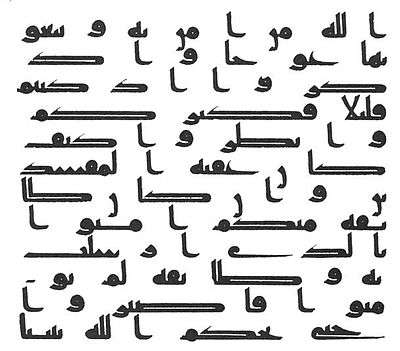Rasm
| Quran |
|---|
 |
|
Rasm is an Arabic writing script often used in the early centuries of Arabic literature (7th century - early 11th century AD). Essentially it is the same as today's Arabic script except for the big difference that dots and dashes (the i‘jām pointing) are omitted. In rasm, the five distinct letters ـبـ ـتـ ـثـ ـنـ ـيـ are indistinguishable because all the dots are omitted. It is also known as Arabic skeleton script.
History
In the early Arabic manuscripts that survive today (physical manuscripts dated 7th and 8th centuries AD), one finds dots but "putting dots was in no case compulsory".[1] Some manuscripts have no dots at all, while others add dots only sparingly and only in phrase contexts where the scribe thinks the omission of dotting on a word would leave the meaning ambiguous.
Rasm (Arabic: رَسْم) means 'drawing', 'outline', or 'pattern' in Arabic. When speaking of the Qur'an, it stands for the basic text made of the 18 letters without the Arabic diacritics which mark vowels (tashkīl) and disambiguate consonants (i‘jām).
Letters
The rasm is the oldest part of the Arabic script; it has 18 elements, excluding the ligature of lām and alif. When isolated and in the final position, the 18 letters are visually distinct. However, in the initial and medial positions, certain letters that are distinct otherwise are not differentiated visually. This results in only 15 visually distinct glyphs each in the initial and medial positions.
| Name | Final | Medial | Initial | Isolated | Rasm | ||||
|---|---|---|---|---|---|---|---|---|---|
| Final | Medial | Initial | Isolated | Code point | |||||
| ʾalif | ـا | ـا | ا | ا | ـا | ـا | ا | ا | U+0627 |
| Bāʾ | ـب | ـبـ | بـ | ب | ـٮ | ـٮـ | ٮـ | ٮ | U+066E |
| Tāʾ | ـت | ـتـ | تـ | ت | |||||
| Ṯāʾ | ـث | ـثـ | ثـ | ث | |||||
| Nūn | ـن | ـنـ | نـ | ن | ـں | ـںـ | ںـ | ں | U+06BA[a] |
| Yāʾ | ـي | ـيـ | يـ | ي | ـى | ـىـ | ىـ | ى | U+0649 |
| Alif maqṣūrah | ـى | ى | |||||||
| Ǧīm | ـج | ـجـ | جـ | ج | ـح | ـحـ | حـ | ح | U+062D |
| Ḥāʾ | ـح | ـحـ | حـ | ح | |||||
| Ḫāʾ | ـخ | ـخـ | خـ | خ | |||||
| Dāl | ـد | ـد | د | د | ـد | ـد | د | د | U+062F |
| Ḏāl | ـذ | ـذ | ذ | ذ | |||||
| Rāʾ | ـر | ـر | ر | ر | ـر | ـر | ر | ر | U+0631 |
| Zayn / Zāy | ـز | ـز | ز | ز | |||||
| Sīn | ـس | ـسـ | سـ | س | ـس | ـسـ | سـ | س | U+0633 |
| Šīn | ـش | ـشـ | شـ | ش | |||||
| Ṣād | ـص | ـصـ | صـ | ص | ـص | ـصـ | صـ | ص | U+0635 |
| Ḍād | ـض | ـضـ | ضـ | ض | |||||
| Ṭāʾ | ـط | ـطـ | طـ | ط | ـط | ـطـ | طـ | ط | U+0637 |
| Ẓāʾ | ـظ | ـظـ | ظـ | ظ | |||||
| ʿayn | ـع | ـعـ | عـ | ع | ـع | ـعـ | عـ | ع | U+0639 |
| Ġayn | ـغ | ـغـ | غـ | غ | |||||
| Fāʾ | ـف | ـفـ | فـ | ف | ـڡ | ـڡـ | ڡـ | ڡ | U+06A1 |
| Qāf | ـق | ـقـ | قـ | ق | ـٯ | ـٯـ | ٯـ | ٯ | U+066F |
| Kāf | ـك | ـكـ | كـ | ك | ـڪ | ـڪـ | ڪـ | ڪ | U+06AA |
| Lām | ـل | ـلـ | لـ | ل | ـل | ـلـ | لـ | ل | U+0644 |
| Mīm | ـم | ـمـ | مـ | م | ـم | ـمـ | مـ | م | U+0645 |
| Hāʾ | ـه | ـهـ | هـ | ه | ـه | ـهـ | هـ | ه | U+0647 |
| Tāʾ marbūṭah | ـة | ة | |||||||
| Wāw | ـو | ـو | و | و | ـو | ـو | و | و | U+0648 |
| Lām + alif | ـلا | ـلا | لا | لا | ـلا | ـلا | لا | لا | U+0644 + U+0627 |
| Hamzah | ء | ء | ء | ء | (None)[b] | ||||
- ^a This character may not display correctly in some fonts. The dot should not appear in all four positional forms and the initial and medial forms should join with following character. In other words the initial and medial forms should look exactly like those of a dotless bāʾ while the isolated and final forms should look like those of a dotless nūn.
- ^b There is no hamzah in rasm writing, including hamzah-on-the-line (i.e., hamzah between letters).
Digital example
Compare the Basmala, the beginning verse of the Qurʾān with all diacritics and with the rasm only. Note that when rasm is written with spaces, spaces do not only occur between words. Within a word, spaces also appear between adjacent letters that are not connected, and this type of rasm is old and not used lately.
| With i‘jām and all diacritics[c] | ﷽ |
|---|---|
| بِسْمِ ٱللَّٰهِ ٱلرَّحْمَٰنِ ٱلرَّحِيْمِ | |
| Rasm only[d] | ٮسماللهالرحمںالرحىم |
| Rasm with spaces[d] | ٮسم ا لله ا لر حمں ا لر حىم |
- ^c The sentence may not display correctly in some fonts. It appears as it should if one of the fonts Scheherazade or Lateef is installed.
- ^d This sentence may not display correctly in some fonts. It appears properly with Scheherazade, Lateef, or DejaVu Sans.
Historical example
The Kufic Samarkand Qurʾan that was from 1869 to 1917 in St. Petersburg shows almost only rasm: Sura 7 (Al-Aʿaraf), verses 86 & 87, of the Samarkand Qur'an, written in unadorned rasm.
| Samarkand Qur'an | Digital rasm with spaces | Digital rasm | Current |
|---|---|---|---|
 |
ا لله مں ا مں ٮه و ٮٮعو | الله مں امں ٮه وٮٮعو | اللَّهِ مَنْ آمَنَ بِهِ وَتَبْغُو |
| ٮها عو حا و ا د | ٮها عوحا واد | نَهَا عِوَجًا وَاذْ | |
| كر و ا ا د كٮٮم | كروا اد كٮٮم | كُرُوا إِذْ كُنْتُم | |
| ڡلٮلا ڡكٮر كم | ڡلٮلا ڡكٮركم | قَلِيلا فَكَثَّرَكُمْ | |
| و ا ٮطر وا كٮڡ | واٮطروا كٮڡ | وَانْظُرُوا كَيْفَ | |
| كا ں عڡٮه ا لمڡسد | كاں عاڡٮه المڡسد | كَانَ عَاقِبَةُ الْمُفْسِدِ | |
| ٮں ڡر و ا ں كا ں طا | ٮں ڡر واں كاں طا | ين٨٧ وَإِنْ كَانَ طَا | |
| ٮڡه مٮكم ا مٮو ا | ٮڡه مٮكم امٮوا | ئِفَةٌ مِنْكُمْ آمَنُوا | |
| ٮالد ى ا ر سلٮ | ٮالدى ارسلٮ | بِالَّذِي أُرْسِلْتُ | |
| ٮه و طا ٮڡه لم ٮو | ٮه وطاٮڡه لم ٮو | بِهِ وَطَائِفَةٌ لَمْ يُؤْ | |
| مٮو ا ڡا صٮر و ا | مٮوا ڡاصٮروا | مِنُوا فَاصْبِرُوا | |
| حٮى ٮحكم ا لله ٮٮٮٮا | حٮى ٮحكم الله ٮٮٮٮا | حَتَّى يَحْكُمَ اللَّهُ بَيْنَنَا |
See also
- Kufic
- Abjad numerals
- History of the Arabic alphabet
- Qiraʾat
- Modern Arabic mathematical notation
- Book Pahlavi, an Iranian script with similar graphemic convergence.
References
- ↑ "What Are Those Few Dots for? Thoughts on the Orthography of the Qurra Papyri (709-710), the Khurasan Parchments (755-777) and the Inscription of the Jerusalem Dome of the Rock (692)", by Andreas Kaplony, year 2008 in journal Arabica volume 55 pages 91-101.
External links
- Some pages from the famous Saint Petersburg-Samerkand-Tashkent Koran. The fourth to seventh images are written in the Kufic script
- A page in the earliest script, known as ma'il